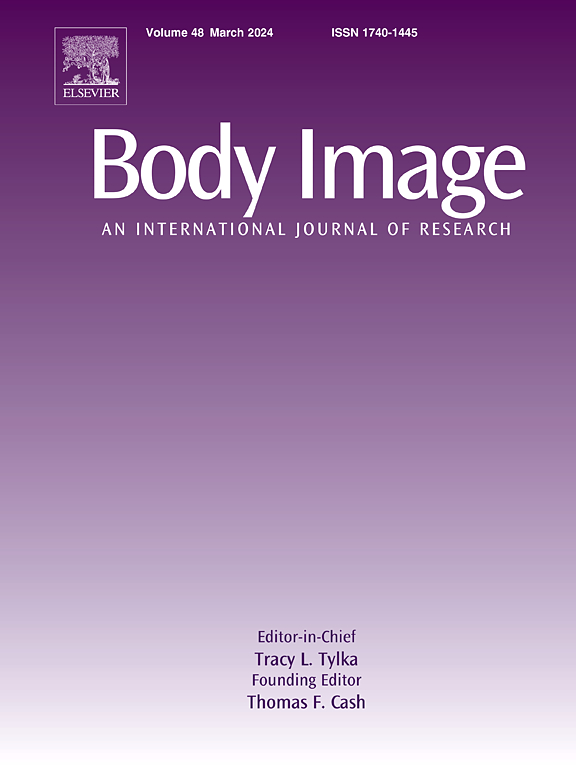中国男孩和女孩饮食失调心理病理的三方影响和社会比较理论:纵向网络视角
IF 5.4
1区 心理学
Q1 PSYCHIATRY
引用次数: 0
摘要
本研究采用纵向网络分析的方法,探讨了三方影响模型(TIM)和社会比较理论在解释中国青少年饮食失调(ED)心理病理中的适用性。共有1428名中国青少年(607名男孩,821名女孩)参加了为期18个月的四波纵向研究。对男孩和女孩进行了单独的个人同期和时间网络估计,两者都显示出足够的网络稳定性。在男孩和女孩的同时期网络中,同伴压力是影响最大的节点,而瘦理想内化和向下的外貌比较表现出最高的桥梁预期影响。在男孩的颞网络中,TIM因素预测了大多数ED症状,而外表比较与ED症状的定向关联有限。在男孩的时间网络中,自我价值感对身材/体重的偶然性的预期内影响最大,同伴压力的预期外影响最大,桥梁中心性最大。相比之下,女孩的时间网络显示TIM和社会比较因素之间的双向关联,两者都与ED症状有方向性联系。此外,在女孩的时间网络中,同伴压力表现出最大的期望内影响,向上的外表比较表现出最大的期望外影响,瘦理想内化和向上的外表比较都具有最高的桥梁中心性。这些发现表明,社会文化影响与ED精神病理之间存在着性别特异性模式的联系,强调了在设计干预措施时,针对关键的性别特异性社会文化因素的潜在重要性。本文章由计算机程序翻译,如有差异,请以英文原文为准。
Tripartite influence and social comparison theories for explaining eating disorder psychopathology in Chinese boys and girls: A longitudinal network perspective
The present study used longitudinal network analysis to investigate the applicability of the tripartite influence model (TIM) and social comparison theories in explaining eating disorder (ED) psychopathology among Chinese adolescents. A total of 1428 Chinese adolescents (607 boys, 821 girls) participated in a four-wave longitudinal study over 18 months. Separate within-person contemporaneous and temporal networks were estimated for boys and girls, both demonstrating adequate network stability. In both boys’ and girls’ contemporaneous networks, peer pressures was the most influential node, while thin-ideal internalization and downward physical appearance comparison exhibited the highest bridge expected influence. In boys’ temporal network, TIM factors predicted most ED symptoms over time, whereas appearance comparisons had limited directional associations with ED symptoms. Also, in the boys’ temporal network, contingency of self-worth on shape/weight showed the highest in-expected influence, and peer pressures had the highest out-expected influence and the highest bridge centrality. In contrast, girls’ temporal network revealed bidirectional associations among TIM and social comparison factors, both of which had directional links with ED symptoms. Furthermore, in girls’ temporal network, peer pressures exhibited the highest in-expected influence, upward physical appearance comparison exhibited the highest out-expected influence, and both thin-ideal internalization and upward physical appearance comparison had the highest bridge centrality. These findings suggest sex-specific patterns linking sociocultural influences to ED psychopathology, highlighting the potential importance of targeting key sex-specific sociocultural factors when designing interventions.
求助全文
通过发布文献求助,成功后即可免费获取论文全文。
去求助
来源期刊

Body Image
Multiple-
CiteScore
8.70
自引率
28.80%
发文量
174
期刊介绍:
Body Image is an international, peer-reviewed journal that publishes high-quality, scientific articles on body image and human physical appearance. Body Image is a multi-faceted concept that refers to persons perceptions and attitudes about their own body, particularly but not exclusively its appearance. The journal invites contributions from a broad range of disciplines-psychological science, other social and behavioral sciences, and medical and health sciences. The journal publishes original research articles, brief research reports, theoretical and review papers, and science-based practitioner reports of interest. Dissertation abstracts are also published online, and the journal gives an annual award for the best doctoral dissertation in this field.
 求助内容:
求助内容: 应助结果提醒方式:
应助结果提醒方式:


